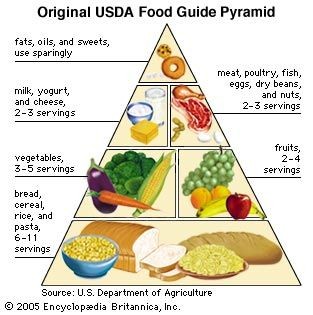The food pyramid, a visual guide to optimal daily food intake, has a fascinating history. Its evolution reflects changing nutritional understanding, cultural adaptations, and responses to societal needs. While the concept might seem straightforward today, the journey to its modern iterations involved numerous individuals and organizations across the globe.
The idea of visually representing dietary guidelines isn’t new. Early attempts focused on addressing food shortages and promoting balanced diets. Let’s delve into the history of this iconic guide and answer the question: who exactly came up with the food pyramid?
The Early Origins of Dietary Guidelines
Before the pyramid shape became popular, other methods were used to guide food choices. During World War II, in 1943, the U.S. Department of Agriculture (USDA) introduced the “Basic 7” food guide. This guide aimed to help Americans cope with food rationing by categorizing foods into seven groups, including bread and cereals, fruits and vegetables, and meat and poultry. While not a pyramid, it was an early attempt to provide dietary recommendations.
Sweden’s Pioneering Role
The direct precursor to the modern food pyramid emerged in Sweden during the 1970s. Facing rising food costs, the National Board of Health and Welfare sought to create a simple, visual guide to healthy eating. Their initial approach involved dividing foods into “basic” and “supplementary” categories. However, this categorization was flawed as essential foods like fruits, vegetables, meat, and fish were grouped as “supplementary.” A dietary circle resembling a cake divided into segments was also used, but it lacked specific portion guidance.
The alt text for the image is: A depiction of the Swedish food pyramid from the 1970s, showcasing the basic food groups organized by recommended consumption levels.
Anna-Britt Agnsäter: The Architect of the Pyramid
The individual most credited with designing the food pyramid is Anna-Britt Agnsäter, an educator working for a Swedish grocery cooperative, Kooperativa Förbundet (KF). In 1974, Agnsäter published the first food pyramid in KF’s magazine, Vi. Her design divided foods into three levels:
- Bottom Level: Bread, grains, legumes, potatoes, and milk.
- Middle Level: Fruits, vegetables, and juices.
- Top Level: Eggs, meat, and fish.
Agnsäter’s key innovation was using the pyramid shape to visually communicate the importance of consuming more foods from the bottom (wider) section and fewer from the top. This intuitive design was quickly adopted by other Nordic countries and beyond.
The USDA’s Adaptation and Evolution
In 1992, the USDA introduced its own version of the food pyramid, drawing inspiration from Agnsäter’s original concept. The USDA pyramid had four levels:
- Bottom Level: Bread, cereal, rice, and pasta (6-11 servings per day).
- Second Level: Vegetables (3-5 servings) and fruits (2-4 servings).
- Third Level: Milk, yogurt, and cheese (2-3 servings) and meat, poultry, fish, dry beans, eggs, and nuts (2-3 servings).
- Top Level: Fats, oils, and sweets (to be used sparingly).
While influential, the USDA’s pyramid faced criticism for its broad carbohydrate recommendations and lack of distinction between different types of fats.
The alternative text for the image is: The 1992 USDA Food Guide Pyramid illustration showing recommended daily intake of grain products forming the base and fats, oils, and sweets at the tip.
MyPyramid and MyPlate: Modern Iterations
Recognizing the need for updated guidance, the USDA replaced its food pyramid with MyPyramid in 2005. This new design featured colorful stripes representing different food groups and emphasized the importance of exercise. However, MyPyramid was later replaced by MyPlate in 2011. MyPlate uses a plate divided into sections representing fruits, vegetables, grains, and protein, with a side of dairy. This model offers a simpler and more visually intuitive approach to balanced meal planning.
The alternative text for the image is: A visual guide called MyPlate, introduced by the USDA in 2011, displaying the recommended proportions of food groups for a balanced diet.
Global Adaptations and Variations
The food pyramid has been adapted and reimagined by various countries to reflect their unique cultures, dietary habits, and nutritional needs. Examples include:
- Canada: Used a rainbow design.
- Zimbabwe: Used a square.
- Guatemala: Used a family pot.
- Japan: Used the number 6 and later a spinning top design.
- South Korea and China: Created pagodas.
- Australia: Designed both pyramids and plates.
These variations highlight the importance of tailoring dietary guidelines to specific populations and contexts.
Debates and Criticisms
Despite its widespread adoption, the food pyramid has faced criticism. Some argue that it oversimplifies complex nutritional concepts and fails to adequately address the nuances of different food types, such as carbohydrates and fats. Concerns have also been raised about the influence of food industry lobbying on dietary recommendations.
Conclusion
While Anna-Britt Agnsäter is widely credited with creating the first food pyramid, the concept has undergone significant evolution and adaptation over time. From the USDA’s initial adoption to the development of MyPyramid and MyPlate, various individuals and organizations have contributed to shaping the way we understand and visualize healthy eating. The ongoing debates and adaptations demonstrate the dynamic nature of nutritional science and the importance of continually refining our dietary guidelines to promote public health.

